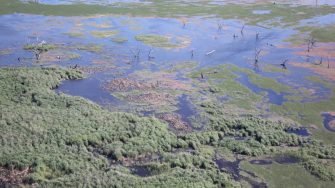
Date: Friday, October 14, 2016
Project: Eastern Australian Waterbird Survey
Observer: Richard Kingsford
Today is the last leg of our northern surveys. The amount of water everywhere is the standout ‘take home’ message from the surveys, as well as the low numbers of waterbirds. They are spread out thinly across the wetlands. The other key observation is that our breeding index, number of broods and nests will be high this year. This is particularly welcome, given so few birds have bred in previous dry years.
From Bourke, we headed south and then east along band number five. There were a few dams to survey, before we hit the rivers that run south to north in the Murray-Darling Basin. Our first one was the Bogan River which is seldom more than a few waterholes where we survey it. Today it had spread out across its floodplain: another sight I have not seen before.
Surveying the Bogan River inundating its floodplain
From here, we surveyed the odd farm dam before hitting today’s highlight – the wonderful Macquarie Marshes. Reece, my other survey partner, had never seen the Marshes and was amazed at the size, complexity and extent of the flooding. It was busy surveying it.
Macquarie Marshes floodplain – with water spreading in all directions
In all of the nine days of surveying some of the more extensive rivers and floodplains in eastern Australia, the Macquarie Marshes was different in many ways. It had the highest diversity and abundance of waterbirds that we have seen so far. Our survey band crosses the northern third of the Macquarie Marshes, an area of river red gum forests and marsh areas. We then headed south to survey potential breeding colonies.
Flying over the reedbeds of the Macquarie Marshes, searching for waterbird breeding colonies.
The vast Macquarie Marshes floodplain stretched north south, over a large area. It remains one of the most important areas for waterbirds and wetlands in Australia. It is internationally recognised for its waterbirds. But these only survive because of the complex mix of habitats and of course the important flooding. It has the most extensive reed beds in the Murray-Darling Basin. Ibis, herons, egrets and cormorants are called colonially breeding waterbirds because they collect in large colonies, breeding only when there is widespread flooding in a productive wetland. This is why the flooding of wetlands and rivers is so important.
Straw-necked ibis, white ibis and egrets nest in concentrated colonies in the Macquarie Marshes. Surveying one of the colonies (yellow/ brown areas in the reedbeds).
The Murray-Darling Basin is the breeding hot spot for these birds and within the basin, the Macquarie Marshes has more breeding sites and a higher diversity of breeding birds than anywhere else. It is a national treasure. Environmental flows and the contribution they make to flooding is critical in sustaining the breeding birds but also the habitats they depend on including the red gum forests, the lignum and reedbeds.
Flooded river redgum forests in the Macquarie Marshes
The building of dams and diversion of water upstream has reduced the frequency, duration and extent of these floods and that’s why environmental flows and large floods such as this one are so important.
Today was fabulous to see three large colonies ‘going’ in the Marshes. Two of these were mainly straw-necked ibis and the third was an egret colony. They looked great from the air. We searched all of the other places that the birds traditionally breed but they weren’t active, as far as we could tell from the air. We quite likely missed birds breeding if they were few in numbers.
One of the colonies of breeding straw-necked ibis in the Macquarie Marshes
From here, there was flooding in the smaller rivers such as the Castlereagh River to the east, until we reached the Namoi River which was largely confined within its banks. We refuelled at Narrabri and then kept surveying a few dams on the way before surveying Split Rock Dam on the Namoi River, an extremely large storage. It was not full, surrounded by verdent green hills. It had its usual complement of cormorants and pelicans were surveyed as well as quite a big flock of nearly a hundred great crested grebes.
Surveying split rock dam which regulates river flows on the Namoi River.
Once this was surveyed, we flew on to survey a few dams around Armidale before heading down to Band 4 which goes out to Myall Lakes where we surveyed some dams and the Hunter River. The western part of this survey band will be surveyed later next week, when the next survey team goes out after the aircraft has been serviced for three days.
